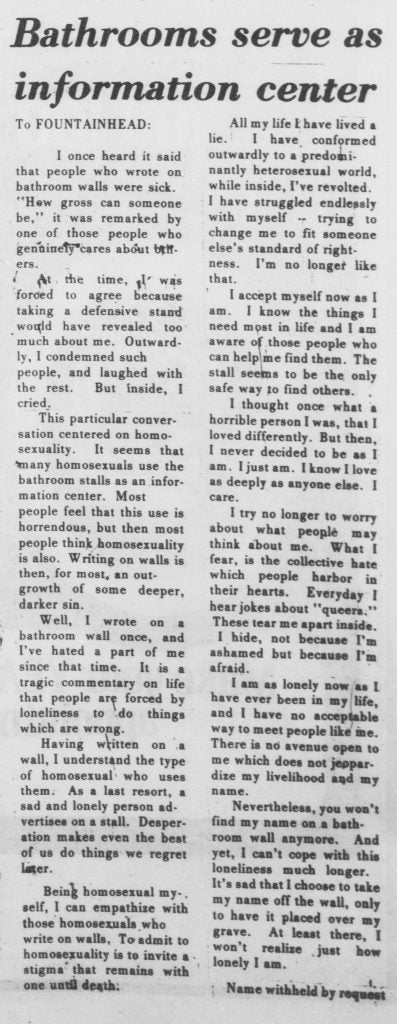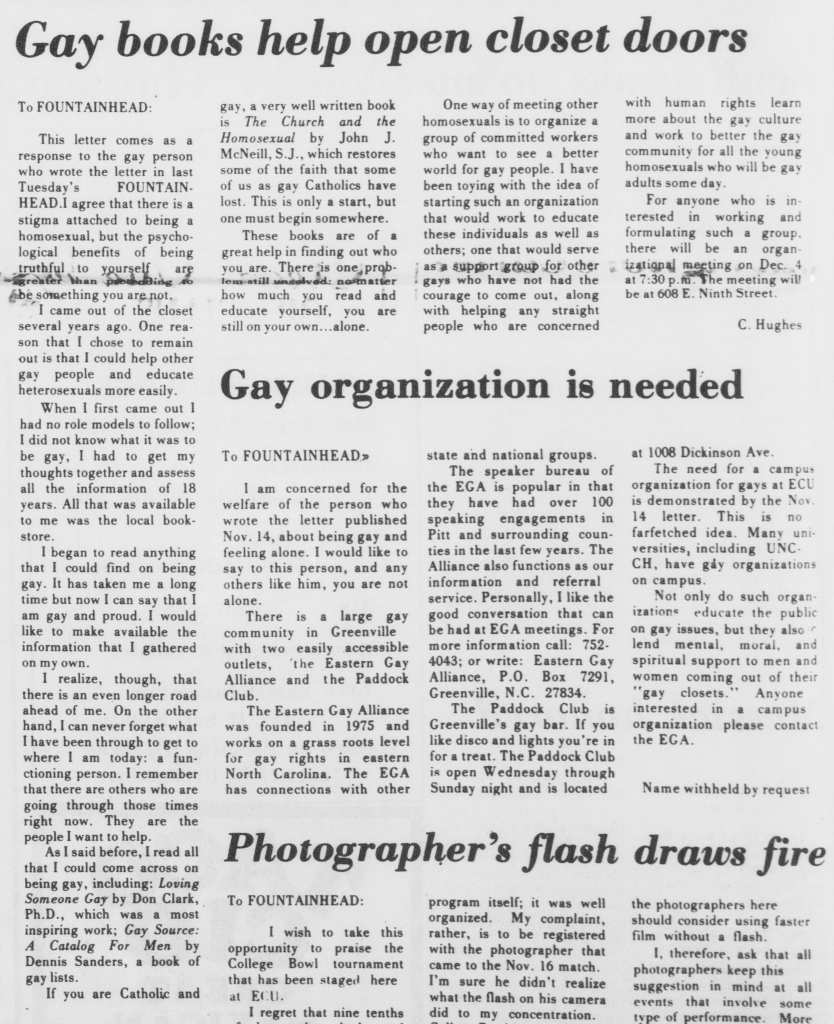Staff Pick: Foundations of LGBTQ Students Organizing at East Carolina University
Collection: East Carolina University Campus Newspapers. UA50-05. University Archives, East Carolina University, Greenville, NC.Staff Person: Zachary Dale
This month’s staff pick covers the series of anonymous letters that sparked the creation of East Carolina University’s first gay student organization forty-one years ago. The first of which was a submission entitled “Bathrooms serve as information center,” which was published in the editorial section of the Fountainhead on November 12, 1978.
This letter, widely considered to be a suicide note, revealed a growing sense of discontent among the gay population on campus. Specifically, concerns were centered around the normalized implicit and explicit homophobia that was running rampant within the student population. The ever-present possibility of violence, whether it be physical or verbal, became a very real concern for gay students at ECU. To make matters worse, the administration and student media had remained largely indifferent to the homophobic activity taking place. Gay students were trapped in a viscous cycle: visibility made them targets for violence, but obscurity allowed for that same behavior to continue unchecked.
While neither the identity or fate of the anonymous writer was revealed, the letter’s message had nonetheless deeply resonated with a number of individuals on campus. It wasn’t until two weeks later that first letters responding to the “Bathrooms” author were published in the newspaper.
The publication of these letters in the Fountainhead reveals a number of serious implications that queer students on campus had to consider. The formation of a gay student group would, whether they wanted it or not, result in a great deal of publicity that could potentially endanger the lives of those it was meant to protect. At the same time, it was clear that gay students desperately needed an organization and that further delay might only make the situation worse. Student organizers would also have to consider the practical issues that came with starting a gay campus organization: Was there anyone even willing to help them get started? Where would they possibly hold their meetings? Faculty and staff certainly might have concerns advising such a group especially given that implication alone was enough to threaten their sense of personal and professional safety. Moreover, concerns regarding the safety of students also meant it was unlikely that this hypothetical organization would even be able to find a place to gather regularly.
Exactly two days after the initial response letters were published, the first announcement regarding the creation of a “university Gay Union” appeared in the Fountainhead. The advertisement not only featured a set date, but an address for the organizational meeting as well.[1]
The address for this initial meeting, listed as 608 East Ninth Street, is of particular importance as it was originally the home of the Newman Catholic Student Center. The nuns leading the center, Sister Helen “Happy” Shondell and Sister Jane Paris, had heard the plight of the gay students at ECU and decided to provide the assistance that these students needed to organize. They offered both the use of their center as a meeting location and their service as pseudo-advisers for the burgeoning group.
The message was clear: gay students were going to organize and more importantly, they weren’t going to do it alone. With the support of the Newman Center, these students were able to form ECU’s first LGBT+ student organization, aptly named the East Carolina Gay Community. Although this organization has been largely lost in the history of campus, the alliance between these two groups would result in what was once referred to as “the most well known, most talked about organization[s] on campus” during the 1980’s.[2]
[1] “Gay Union,” Fountainhead, November 30, 1978.
[2] “East Carolina Gay Community,” Ebony Herald, September 1982.
Sources:


